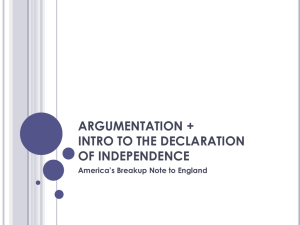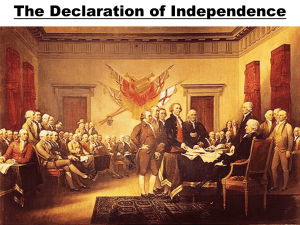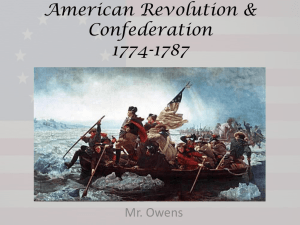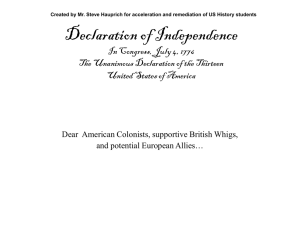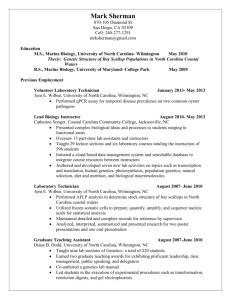The American Revolutionary War April 17 th, 1775
advertisement
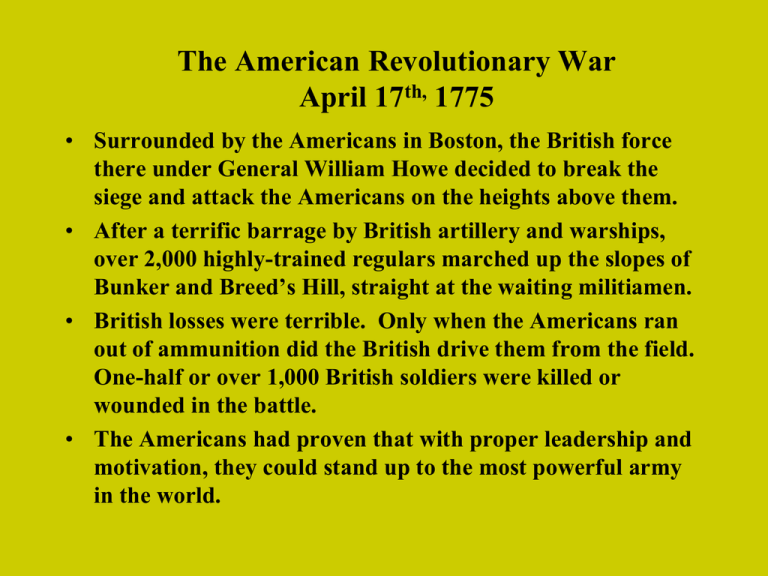
The American Revolutionary War April 17th, 1775 • Surrounded by the Americans in Boston, the British force there under General William Howe decided to break the siege and attack the Americans on the heights above them. • After a terrific barrage by British artillery and warships, over 2,000 highly-trained regulars marched up the slopes of Bunker and Breed’s Hill, straight at the waiting militiamen. • British losses were terrible. Only when the Americans ran out of ammunition did the British drive them from the field. One-half or over 1,000 British soldiers were killed or wounded in the battle. • The Americans had proven that with proper leadership and motivation, they could stand up to the most powerful army in the world. The War in North Carolina Moore’s Creek Bridge, February 27th, 1776 The first battle of the Revolution in North Carolina. NC Loyalists were trying to join up with regular British soldiers. The Patriots hid alongside of Moore’s Creek and ambushed the Loyalists when they marched across the bridge. In the three-minute battle, over 50 Loyalists were killed and nearly their entire force was captured by the Americans. This battle helped ensure that the British would not gain complete control over the Southern colonies. The Halifax Resolves • Adopted on April 12th, 1776. • A group of North Carolina Patriots adopted the Halifax Resolves, which advocated for the very first call for independence from Great Britain. • “To concur with the delegates of other Colonies in declaring Independency, and forming foreign alliances, reserving to this colony the sole and exclusive fight to forming a Constitution and laws for the Colony.” • Not only did the resolves call for NC to do so, but it also asked that all the 13 colonies do so as well. • Not long after this, the Declaration of Independence was drafted. • North Carolina also appointed its first governor at this time. The man was Richard Caswell and he had been an important Patriot leader at the Battle of Moore’s Creek Bridge. The Declaration of Independence -A Time of Decision• On July 4th, 1776, the Declaration of Independence was adopted and ratified by the Congress. • The basic principle of the document was that people across the world have certain, unalienable rights that a government cannot take away. • These rights are, Life, Liberty and the Pursuit of Happiness. • The Congress reasoned that if a government disregards these rights, then it loses its rights to govern. The people then have the right to abolish that government by force, if necessary. • The Declaration also specifically outlined the reasons why the colonies were breaking away from England and what King George III had done to them. There were 27 grievances listed in all against King George and Great Britain. • Now, the only thing that the colonies had to do was win the war. Men From North Carolina That Signed the Declaration of Independence • Joseph Hewes - Born into a Quaker family with strong religious convictions. Becoming a well-known merchant in Edenton, Hewes was elected into the NC Colonial Assembly in 1766. • John Penn – After practicing law in Virginia for 12 years, Penn moved to Granville County, NC in 1775 when he was chosen to become a delegate at the Continental Congress. • William Hooper – Moving to NC from Massachusetts in 1764, Hooper was a well-known lawyer that also served as a delegate at the Continental Congress. The Signers of the Declaration of Independence Besides Thomas Jefferson and Benjamin Franklin, there were 54 other signers of this document. Out of these 56, 29 of the men held Seminary degrees! Roger Sherman Roger Sherman, one of the 56 signers, was the only American to sign all four of the great state papers that created the United States: the Continental Association, the Declaration of Independence, the Articles of Confederation, and the Constitution of the United States. Thomas Jefferson once said of Sherman, “That is, Mr. Sherman, of Connecticut, is a man that never said a foolish thing in his entire life.” Sherman was also one of the five who drafted the Declaration. Benjamin Rush Rush, another signer of the Declaration, was a physician, writer, educator, humanitarian, and a devout Christian. He was also an early opponent of the institution of slavery and capital punishment. In addition to being an active member of the Sons of Liberty, Rush also assisted Thomas Paine in writing his famous work, “Common Sense.” The Declaration being read aloud to the Continental Army. The North Carolina Constitution of 1776 Once the Declaration of Independence was adopted, British laws and royal governors were no longer recognized within the colonies. In North Carolina, a committee appointed by the newly-created provincial congress wrote the state’s first constitution. This new constitution drew upon the English Bill of Rights and upon the constitutions of several other states. Unlike the old, royal government, the majority of the powers were given to the men of the assembly and not the royal governor. It also required that all persons running for office be of the Protestant faith. North Carolina’s First Independent Governor When the Patriot leaders in North Carolina, along with the other 12 colonies, declared independence from Great Britain, they immediately began organizing a new state government, free from British rule and influence. In 1777, Richard Caswell, a well-known soldier and American statesman, became the first governor of the state of North Carolina. He would then guide the state throughout the trying years of the Revolutionary War.

